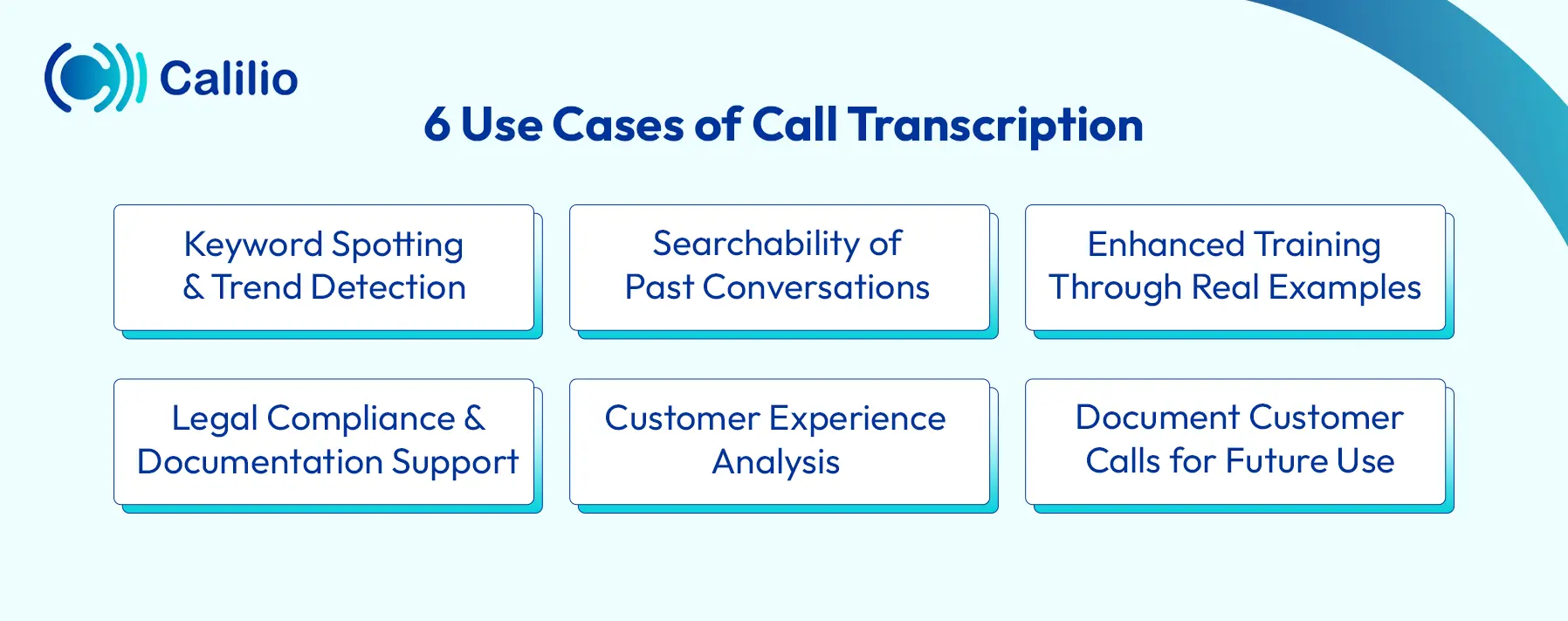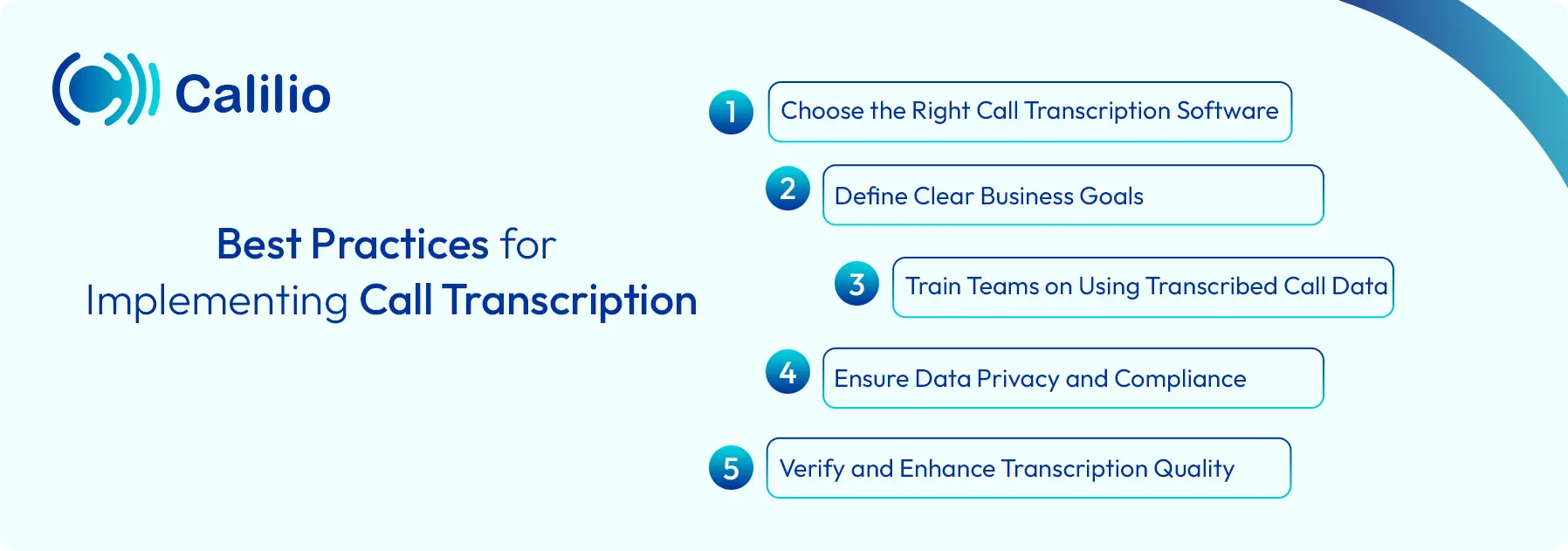6 Call Transcription Use Cases to Transform Business Efficiency

Calls often contain important information that can be easily missed or forgotten, resulting in confusion and missed opportunities. Keeping track of every detail during a conversation can be challenging, especially when relying on memory or manual notes.
Call transcription provides a simple and effective solution. By converting spoken words into accurate, searchable text, call transcription helps individuals and businesses capture, review, and utilize call information with ease.
In this blog, we’ll explore six call transcription use cases to show how it can improve your communication and workflow.
Key Highlights:
Call transcription transforms voice calls into text, enabling teams to quickly reference and analyze past conversations for customer service, compliance, or sales performance.
By analyzing transcribed calls, businesses can automatically detect trends or key phrases, enhance training, and improve customer experience.
To implement call transcription effectively, choose a secure and accurate transcription tool, ensure legal compliance by informing participants, and integrate transcripts into your workflows to improve quality monitoring.
Benefits of Call Transcription in Business
Call transcription captures accurate conversation records, reducing miscommunication, improving customer service, ensuring easier information retrieval, and helping with compliance and documentation.
1. Improved Accuracy
Call transcription reduces human errors that can occur when relying on memory or manual note-taking. By converting every conversation into a detailed, precise text record, businesses can ensure all information is captured correctly.
2. Better Customer Experience
By accurately capturing each customer's conversation, businesses can better understand their needs, preferences, and pain points. This enables more personalized responses and faster issue resolution, ultimately leading to improved customer satisfaction.
3. Quality Assurance
Call transcription provides managers with a detailed record of customer interactions, enabling thorough review and evaluation of agent performance. It helps identify areas for improvement, ensures consistent service standards, and supports ongoing training.
4. Faster Documentation and Note-Taking
With call transcription, employees no longer need to take notes during or after calls. The entire conversation is automatically converted into text, saving time and effort.
5. Supports Decision-Making
Detailed records of customer interactions allow leaders to evaluate current strategies and identify key trends. So, the transcript information enables agents to make informed, data-driven decisions that enhance business performance and better meet customer needs.
6. Faster Information Access
With searchable call transcripts, businesses can quickly locate essential details from past conversations without having to replay recordings. It helps to speed up complaint resolution, sales follow-ups, and compliance checks, improving efficiency and saving valuable time across teams.
7. Enhanced Collaboration
When telephony conversations are transcribed, teams gain instant access to a written record that can be easily shared with colleagues who couldn’t attend the call. It ensures everyone stays informed and supports smoother collaboration across time zones, departments, and remote work environments.
6 Use Cases of Call Transcription
Call transcription helps businesses solve real-world problems, like tracking customer issues, training teams, ensuring compliance, and improving workflows. Below are six practical ways companies are using it to work smarter and achieve better results.

1. Keyword Spotting and Trend Detection
By transcribing calls into text, businesses can easily identify specific keywords and phrases mentioned during conversations. It helps you to spot common topics like complaints, product names, or service requests without manually listening to each call.
The keyword data can be used to categorize conversations, flag common pain points, and refine customer service responses. It also provides valuable input for marketing, product development, and team training efforts.
2. Searchability of Past Conversations
After a call is transcribed, it becomes much easier to search through conversations using simple keywords or phrases. It eliminates the need to manually listen to long audio files, saving time and improving productivity for teams.
Quick access to transcripts improves efficiency across departments, whether for customer support referencing a previous complaint, legal teams reviewing compliance, or managers analyzing interactions for quality assurance.
3. Enhanced Training Through Real Examples
Call transcripts provide a clear and accurate record of customer conversations. Its clarity allows managers to select specific examples from calls to highlight successful interactions or identify mistakes that need correction.
By using call transcripts, training becomes more relevant and impactful, enabling teams to identify best practices and areas for improvement. It helps boost confidence and effectiveness in call handling.
4. Legal Compliance and Documentation Support
Accurate call transcriptions help maintain legal compliance and support conflict resolution processes. It provides a detailed record of conversations, allowing companies to verify promises, instructions, and disclosures made during calls. This ensures that businesses have reliable documentation to protect against claims, resolve misunderstandings, and fulfill regulatory requirements such as data retention laws.
Furthermore, in legal disputes or investigations, transcriptions act as evidence that clarifies facts without relying on the customer's memory or incomplete summaries. It also enhances transparency and accountability, strengthening trust between companies, customers, and regulators.
5. Customer Experience Analysis
Transcribed calls provide insights into the customer experience, which helps to analyze sentiment, language, and conversation flow. Businesses can detect emotional signals or dissatisfaction that might not be obvious from call metrics.
Additionally, understanding customer feedback through transcription analysis enables personalization and more responsive service. It helps build loyalty, increase retention rates, and strengthen brand reputation in competitive markets.
6. Document Customer Calls for Future Use
Accurately documenting customer calls creates a valuable archive that can be accessed for future reference, ensuring consistency and continuity in customer service. Detailed call records allow teams to quickly review past conversations, understand customer needs, and customize solutions based on previous interactions.
Having well-documented call histories improves communication across departments, helping sales, support, and management provide a smooth customer experience. It also helps to track recurring issues, measure service effectiveness, and prepare for follow-ups, strengthening long-term customer relationships.
Best Practices for Implementing Call Transcription
To implement call transcription successfully, focus on selecting reliable tools, protecting customer data, and tailoring the system to your specific needs.

1. Choose the Right Call Transcription Software
When selecting a transcription system, prioritize software that supports your industry’s language and terminology and integrates well with your existing systems, such as CRM and analytics platforms.
2. Define Clear Business Goals
Identify the main objectives for using call transcription, such as improving customer service, ensuring compliance, or saving time. Clear goals ensure call transcription delivers meaningful insights, supports key objectives, and maximizes its value across your operations.
3. Train Teams on Using Transcribed Call Data
Provide your team with practical training to confidently analyze and apply call transcripts for enhancing service quality, compliance, and decision-making.
4. Ensure Data Privacy and Compliance
Strictly follow all applicable regulations concerning call recording and transcription. Obtain explicit consent from participants, implement robust security measures for data protection, and align with industry standards to maintain customer trust and mitigate legal risks.
5. Verify and Enhance Transcription Quality
Continuously monitor the quality of transcribed data to maintain high accuracy. Use regular audits, feedback from users, and system adjustments to refine performance and ensure transcripts provide dependable insights.
Conclusion
Call transcription helps businesses capture and analyze customer interactions more effectively, turning conversations into valuable insights. By using the insights from transcribed calls, organizations can improve customer service, ensure compliance, smooth workflows, and enhance employee training.

Get Cashbacks Up to 43% Straight To Your Wallet!
Unlimited Virtual Numbers – Local, Mobile & Toll-Free from 100+ Countries
Free Local Phone Number from US or Canada
Crystal-Clear Calls Starting at Just $0.0153/min
24/7 Human Support – Because Great Service Never Takes a Holiday


Frequently Asked Questions
What is the difference between call transcription and call recording?
Call recording is the act of capturing the audio of a phone call, while call transcription involves transcribing the audio into text.
Who typically uses call transcription in a business setting?
How does call transcription improve customer experience?

Still have questions?
Can’t find the answer you’re looking for? Please chat with our friendly team.
Stay in the loop
Get the latest call insights, trends, and updates delivered straight to your inbox.
By subscribing, you agree to receive updates from Calilio.
You can unsubscribe anytime.